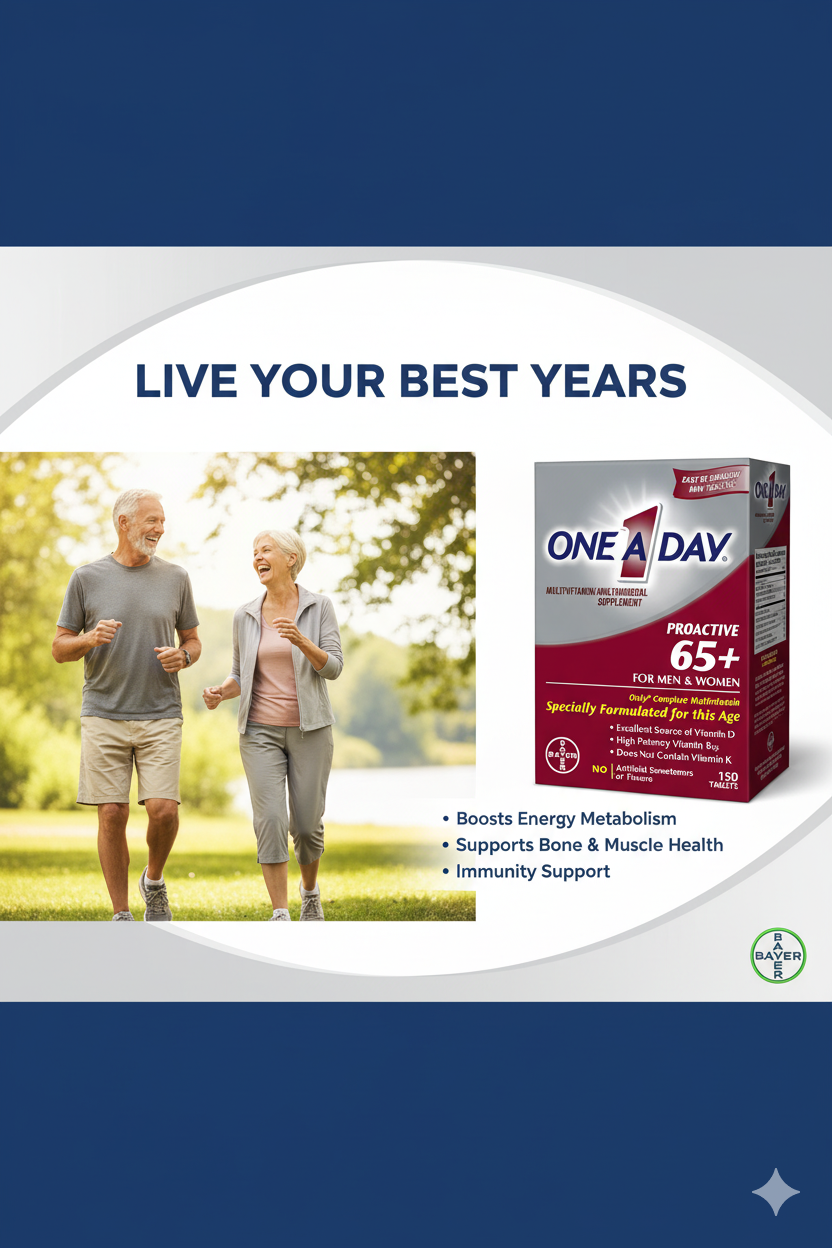Description
If you’ve seen One A Day Proactive 65+ lining pharmacy shelves and thought, “Perfect—this must be exactly what my body needs now that I’m over 65,” hold that thought. While it’s marketed as a proactive multivitamin for seniors, the science behind it is far more nuanced—and, in some cases, concerning.
🧬 “What’s Inside This Vitamin, and Why Should I Care?”
Think of One A Day Proactive 65+ as a multivitamin built for older digestive systems.
As we age, our stomach acid drops, which makes it harder to absorb nutrients like Vitamin B12. This supplement uses crystalline (synthetic) B12—a form that doesn’t rely on stomach acid for absorption. That’s a big plus for older adults.
But there’s a catch: high doses of some vitamins can become a double-edged sword.
| 🌟 Nutrient | 💪 Why It’s Included | ⚠️ What to Watch For |
|---|---|---|
| Vitamin B12 (50 mcg / 2083% DV) | Compensates for poor absorption in seniors | Possible link between chronic high-dose use and cancer risk in some studies |
| Vitamin D (30 mcg / 1200 IU) | Supports bone and heart health | Safe, but avoid stacking with other D supplements |
| Folate (665 mcg DFE) | Prevents anemia and supports heart health | Can “mask” B12 deficiency—neurological risk if used without monitoring |
| No Iron or Vitamin K | Reduces drug interactions (especially with blood thinners) | Great for safety—but not suitable if you actually need Iron or Vitamin K |
| Zinc, Selenium, Magnesium | Boost immunity and support metabolism | Magnesium is low-dose—may need extra if diet is poor |
💡 Explain Like I’m Five:
This vitamin is like a smart seatbelt—it protects you in the right places (no Vitamin K for blood thinners), but if you wear it wrong (too many B vitamins for too long), it can still hurt you.
🩺 “Why Is the Lack of Vitamin K and Iron a Big Deal?”
Smart design choice! Most seniors don’t need extra iron—it can build up and cause stomach issues.
But the real genius is leaving out Vitamin K.
Why? Because Vitamin K thickens blood, and many seniors are on blood thinners like Warfarin.
Including Vitamin K could undo the effect of those meds, leading to dangerous blood clots.
🧩 In short:
No Vitamin K = safer for people on anticoagulants.
⚠️ “So… Are the B-Vitamins Too High?”
Yes—and that’s where the red flags start.
The combination of high-dose Folate (665 mcg DFE) and Vitamin B12 (50 mcg) has raised eyebrows in clinical studies.
Long-term trials found links between chronic high intake of both and increased cancer risks—especially colorectal and prostate cancer.
| 🔬 Study Finding | 📈 Risk Observed |
|---|---|
| Folic Acid + B12 (400 mcg + 500 mcg) | Higher overall cancer rates in 65+ adults |
| Meta-analysis (10 trials) | 24% higher prostate cancer risk with long-term folate use |
⚕️ Translation:
Too much of a good thing—especially over years—might increase cell growth in unwanted ways.
That doesn’t mean you’ll get cancer from taking it, but it’s not “the more the better.”
💡 Pro Tip:
If your doctor hasn’t confirmed a B12 or Folate deficiency, avoid doubling up with this multivitamin plus other fortified foods or supplements.
🧪 “What About Quality and Purity?” — The Certification Problem
Here’s a big oversight: One A Day Proactive 65+ is not verified by USP or NSF—the gold standards for supplement testing.
That means:
- There’s no public proof that every batch is contaminant-free.
- The label claims rely entirely on manufacturer self-reporting.
- Consumers have to trust, not verify, the product’s integrity.
| 🧾 Quality Factor | ✅ Ideal Standard | ❌ One A Day 65+ Status |
|---|---|---|
| USP/NSF Seal | Ensures label accuracy, contaminant testing | ❌ Missing |
| Artificial Colors | Preferably none | 🚫 Contains FD&C Yellow #6 (linked to hypersensitivity) |
| Ease of Use | Small or coated for swallowing ease | 😬 Large tablets, 2 daily required |
💬 Bottom Line: For a supplement aimed at seniors (many of whom struggle to swallow pills), the form factor and unnecessary coloring are major turn-offs.
🧠 “Why Two Tablets? Isn’t It Called One A Day?”
Yes—and it’s confusing.
Despite the brand name, you actually need to take two tablets daily to get the full dose.
If you only take one (as many do), you’re only getting half the vitamins—like paying for a full tank and driving off with half.
| 🚦 What Happens If You Take Only One? | 🧩 Effect |
|---|---|
| Half the Vitamin D | Less bone protection |
| Half the Magnesium | Weaker blood pressure support |
| Half the B12 | Insufficient for absorption issues |
💡 Pro Tip:
Always check the Supplement Facts label—marketing names can mislead, but the dosage chart tells the truth.
🌤️ “How Does It Compare to Centrum Silver?”
Good question. Here’s a snapshot:
| 🧴 Nutrient | 🥇 One A Day 65+ | 🥈 Centrum Silver 50+ | 🧭 Verdict |
|---|---|---|---|
| Vitamin D | 1200 IU | 1000 IU | ✅ Higher dose, better for bone health |
| Vitamin B12 | 50 mcg | 25 mcg | ✅ Stronger absorption support |
| Vitamin K | 0 mcg | 30 mcg | ✅ Safer for Warfarin users |
| Iron | 0 mg | 0 mg | ⚖️ Both safe |
| Certification | None | USP Verified | ❌ Centrum wins for trustworthiness |
📊 Summary:
One A Day 65+ wins for targeted formulation (especially for Warfarin users), but Centrum Silver wins for third-party verification and gentler B-vitamin dosing.
🩹 “So, Who Should Actually Take This?”
Best suited for:
- Seniors on blood thinners (no Vitamin K = safe)
- People with poor B12 absorption (due to age-related low stomach acid)
- Adults needing extra Vitamin D for bone support
Use with caution if:
- You already take fortified foods or extra B-vitamin supplements
- You have a history of cancer or precancerous conditions
- You struggle with swallowing pills or have color dye sensitivities
💬 Final Thoughts: A Smart Formula—With Serious Fine Print
| 💡 Feature | 💚 Pro | ⚠️ Con |
|---|---|---|
| High B12 + No Vitamin K | Great for seniors on Warfarin | Long-term cancer risk debated |
| Strong Vitamin D dose | Excellent for bone strength | Overlap with other supplements possible |
| No Iron | Reduces stomach upset | Not ideal if you’re anemic |
| No USP/NSF seal | — | Quality transparency gap |
| Two-pill dosage | Custom control | Confusing branding (“One A Day”) |
🧭 Quick Recap: Smart Supplement Strategy for Seniors
✅ If you’re 65+ and on Warfarin → This is one of the safest multivitamins.
⚠️ If you’re 65+ and healthy → Choose a USP-verified brand with moderate B-vitamin levels.
💬 Always consult your doctor → Especially before combining with fortified foods or prescription meds.
💬 FAQs
💬 Comment: “Can I take One A Day Proactive 65+ if I’m not on Warfarin?”
Yes—but with caution. The absence of Vitamin K in this formula is a safety measure for individuals taking anticoagulants like Warfarin. However, if you’re not on blood thinners, this omission becomes a potential nutritional gap rather than a benefit.
Vitamin K is essential for bone mineralization and vascular health. Without it, your calcium may not be directed effectively to bones, possibly leading to calcium misplacement in arteries (vascular calcification) over time. If you’re relying solely on this multivitamin, you’re missing a critical cofactor for bone strength.
| 👴 Taking Warfarin? | 💊 Proactive 65+ is ideal—no Vitamin K means safer INR control |
|---|---|
| 🚫 Not on Warfarin? | Might need supplemental K2 (MK-7) to support bone health |
🧠 TL;DR: No Warfarin? Talk to your doctor about supplementing with a Vitamin K2 product separately.
💬 Comment: “Is it safe to take this vitamin with other B-complex supplements?”
Stacking B-complex on top of this formulation is risky unless a deficiency has been clinically confirmed. One A Day Proactive 65+ already contains very high doses of several B vitamins, including:
- Vitamin B12: 2083% DV
- Folate (Folic Acid): 166% DV
- Niacin, B6, B5, Riboflavin at 100–200% DV
Exceeding tolerable upper limits—especially for Folic Acid and Vitamin B6—may lead to:
- Neuropathy (with B6 doses >100 mg/day long-term)
- Masking of B12 deficiency (with high Folate alone)
- Potential tumor proliferation risks in susceptible individuals
| 🔬 B-Vitamin | ✅ Safe Alone | ⚠️ Risk If Stacked |
|---|---|---|
| B12 | ✔️ Yes | Possible long-term cancer link at high doses |
| Folic Acid | ✔️ Yes | Masks B12 issues + cancer risk in studies |
| B6 | ✔️ Yes | Neuropathy risk if stacked |
🧠 TL;DR: Don’t double-dose without lab results. More isn’t always better with B-vitamins.
💬 Comment: “Why is there Yellow #6 in a senior health product?”
Great question—and a valid concern. FD&C Yellow #6 (Sunset Yellow) is a synthetic azo dye used for aesthetic appeal, but it offers no health benefit and may trigger reactions in sensitive individuals.
Potential issues:
- Hypersensitivity reactions like skin rashes or asthma
- Possible links to behavioral issues in children (though research is limited in adults)
- Unnecessary additive in a product targeting an older, medically fragile demographic
| 🎨 Ingredient | 🚫 Purpose | ⚠️ Concern |
|---|---|---|
| Yellow #6 Lake | Coloring only | Linked to hypersensitivity; banned in some countries |
🧠 TL;DR: It’s a cosmetic choice, not a medical one. If you’re dye-sensitive or prefer clean-label supplements, this may be a dealbreaker.
💬 Comment: “I heard calcium is listed but not in the nutrition facts—what gives?”
That’s correct—and confusing. Calcium Carbonate is listed as an inactive ingredient, but the label doesn’t specify how much elemental calcium you’re actually ingesting. This omission creates uncertainty, especially for seniors monitoring their total calcium intake for bone health or risk of hypercalcemia (too much calcium in the blood).
Calcium Carbonate is about 40% elemental calcium, so if a tablet contains 500 mg of Calcium Carbonate, you’re getting 200 mg of elemental calcium—but this is speculative without disclosure.
| ⚖️ Ingredient | 📦 Label Info | ❓ Clinical Impact |
|---|---|---|
| Calcium Carbonate | Inactive, no % DV listed | Patients can’t track total intake |
🧠 TL;DR: Lack of transparency here forces guesswork. Always ask your doctor before pairing this with other calcium products.
💬 Comment: “How does this compare with taking separate targeted supplements?”
A multivitamin offers convenience—but not full customization. If you take One A Day Proactive 65+, you’re receiving broad but generic coverage. However, certain conditions benefit from targeted therapeutic dosing that this product doesn’t support.
For example:
- Macular degeneration? You’d need AREDS2-level Lutein and Zeaxanthin—not included here.
- Bone loss? The calcium and magnesium are underdosed unless you supplement separately.
- Neuropathy or memory issues? You may need Methylcobalamin B12 or Methylfolate, not the synthetic versions here.
| 🧴 Approach | 👍 Advantage | 👎 Limitation |
|---|---|---|
| One A Day 65+ | Convenient, covers basics | May miss condition-specific needs |
| Targeted Supplements | Tailored to your diagnosis | More pills, more expense |
🧠 TL;DR: If you have complex health issues, one-size-fits-all may not fit you. Get labs, and customize.
💬 Comment: “Why do they give you 2083% of B12? Isn’t that dangerous?”
This mega-dose B12 is actually intentional. Older adults often suffer from atrophic gastritis, which reduces stomach acid and inhibits B12 absorption from food. The crystalline B12 in supplements bypasses this—but only a small percentage is passively absorbed.
So, 2083% DV (~50 mcg) isn’t as extreme as it seems—it’s designed to make up for poor absorption.
That said, long-term studies suggest possible increased cancer risk when combined with high-dose folic acid, particularly in older adults.
| 🧠 Why so much B12? | ⚠️ Absorption is low in seniors, so dose is high |
|---|---|
| 🚫 Danger zone? | Not toxic, but may contribute to cancer risk when stacked with Folate over years |
🧠 TL;DR: Not dangerous in the short term—but don’t stack it with fortified cereals or B12 shots without checking with your doc.
💬 Comment: “Is this really better than food?”
No multivitamin can beat a balanced diet. One A Day Proactive 65+ is best viewed as a backup, not a replacement. It can help fill in nutritional gaps, especially for seniors with poor appetite, digestive issues, or medication interference.
But whole foods offer:
- Phytonutrients and fiber (not found in pills)
- Bioavailability synergy (nutrients working together)
- Lower risk of toxicity or imbalance
| 🥦 Whole Foods | 💊 One A Day Proactive 65+ |
|---|---|
| 🍽️ Nutrient-rich, balanced | 🧾 Convenient, gap-filler |
| 👍 Supports gut health | 🚫 Doesn’t replace meals |
| ⚖️ Self-regulating doses | ⚠️ High-dose, synthetic compounds |
🧠 TL;DR: Use this multivitamin as a seatbelt—not a substitute steering wheel. Real food still drives the bus.
💬 Comment: “If it’s not USP-verified, should I worry about contamination?”
Possibly. Without a USP or NSF seal, there’s no independent confirmation that this product:
- Contains what it says it does
- Is free of heavy metals, pesticides, or microbial contaminants
- Was produced under good manufacturing practices
For many seniors, especially those with compromised immunity or multiple medications, this lack of certification represents a safety blind spot.
| 🧪 Certification | 🛡️ What It Proves | ❌ One A Day 65+ Status |
|---|---|---|
| USP / NSF | Ingredient accuracy, safety testing | Not listed or claimed |
🧠 TL;DR: If purity matters to you, opt for a supplement with the USP or NSF logo right on the label.
💬 Comment: “Can I cut the pills in half if they’re too big?”
Unfortunately, not safely. These tablets are often film-coated to protect certain nutrients from moisture or stomach acid. Breaking them can disrupt stability, release timing, or taste—and may even expose you to unbuffered minerals that irritate your stomach lining.
If swallowing is a problem (which it often is in seniors), consider:
- Liquid multivitamins
- Gummies (though often missing some nutrients)
- Smaller, single-nutrient pills tailored to your needs
| 💊 Pill Cutting | ❓ Is It Safe? | 🔄 Better Option |
|---|---|---|
| Film-coated multivitamin | 🚫 Usually not recommended | Switch to smaller or liquid version |
🧠 TL;DR: Don’t DIY pill splitting unless a pharmacist gives the green light. Better to find a version made for easier swallowing.




Reviews
There are no reviews yet.